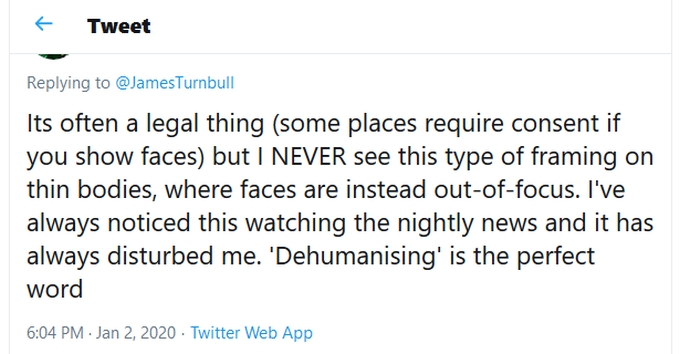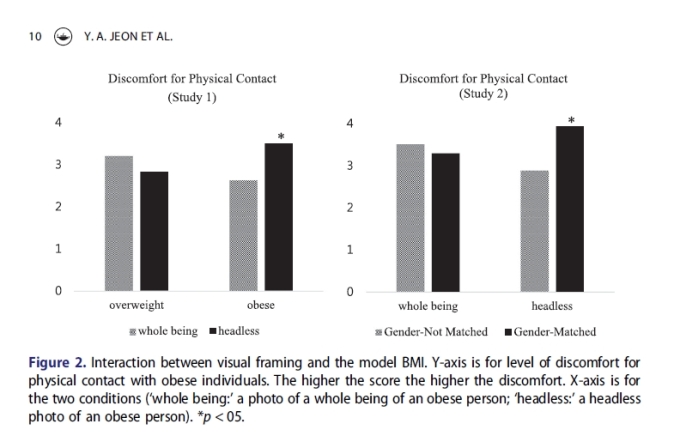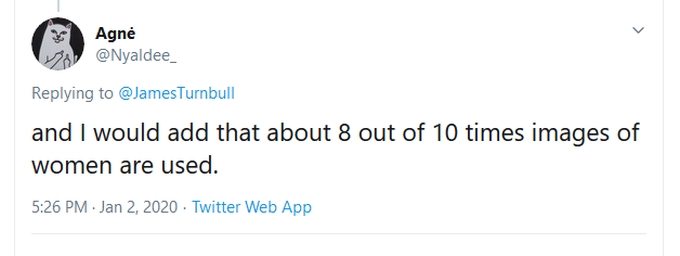Nearly 6 in 10 news articles about obesity are accompanied by headless images of obese people. In the first of its kind, a recent study demonstrates a direct, dehumanizing effect.
For most people, focusing on body parts is the very definition of objectification. Remove subjects’ faces in particular, and you remove the individuality and implied consent communicated. But context is everything. You could critique the “real women have curves” philosophy behind this women-only gym’s name for instance, or the slut-shaming that used to compel Korean lingerie models to hide their faces, but it’s difficult to take issue with the ensuing, headless ads themselves. In music videos and art too, viewers are generally reluctant to judge objectification in isolation. And rightly so: anyone (i.e. everyone) who’s ever discretely admired someone’s magnificent legs, breasts, muscular arms, broad shoulders, or six-pack from afar knows it is possible to like whatever body parts do it for you, while still completely respecting their owners.
Such imagery is pervasive however, nor is every viewer of it as woke as you. You sense there are real consequences for the objectified. But evidence is mixed, as a direct causal link is difficult to prove.
A recent study of the effects of common visual depictions of obese people in the news, however, may provide one. But may also be very specific to obesity.
Among major news outlets in the US, as many as nearly 6 out of 10 articles about obesity issues are accompanied by headless images of obese people. To non-obese people especially, this figure may sound high, but not necessarily a problem. To be sure, we’re all aware of fatty jokes and stereotypes in pop-culture, but news stories about obesity would seem to have that objective, factual context that obviated any potential negative effects. Namely, just like a bra ad featuring only a women’s chest in said bra is acceptable and expected, whereas the same shot of a non-consenting spycam victim would be a crime, that news articles about obesity would tend to be accompanied by pictures of obese people seems logical. That their editors, whether for reasons of civility, consideration, and/or privacy laws would choose to hide or cut out their faces, we can assume would almost always be well-intended. Yet the study shows that the ensuing headless images are precisely the ones that are most damaging. Indeed, obese people themselves, frustrated with almost only ever seeing bulging stomach and butt-shots of themselves in articles specifically about them, might be somewhat less surprised to learn that such images now have a proven dehumanizing effect.
 Surrealist Composition by Friedrich Schroder-Sonnenstern, 1965. Source: WikiArt.
Surrealist Composition by Friedrich Schroder-Sonnenstern, 1965. Source: WikiArt.
But those effects may be very specific to obesity due to the premise of the study, outlined in the opening paragraph (my emphasis, in the first of what I promise will only be two long copy and pastes):
Why would a human feel uncomfortable shaking hands with another human being? The answer from evolutionary psychology would be that the human brain is predisposed to ‘infer’ that a person carries a contagious disease if the person has a bodily cue that is grossly different in form or size from norms (Park, Schaller, & Crandall, 2007). This cognitive bias induces disease-avoidance responses including disgust or avoidance of physical contact with the possessor of unusual bodily cues (Park et al., 2007). An obese human body is one of the visual cues or ‘marks’ triggering such aversive responses (Park et al., 2007; Smith, 2012). Evidence from social neuroscience indicates that disease-avoidance responses inhibit or block cognitive processing of humanly unique traits such as high rationality of a person with the disease-relevant signs (Harris & Fiske, 2007). In this way, the possessor of the disease-relevant signs such as an obese body is perceptually dehumanized. In turn, the heightened dehumanizing perception could lead to exclusionary attitudes toward obese individuals (Buckels & Trapnell, 2013).
In other words, obesity mimics the symptoms of many communicable diseases, and the consequences of assuming a diseased person is healthy and safe to physically interact with are usually greater than shunning an apparently diseased person who is in fact healthy. Therefore, exposure to obesity, prompted and exaggerated by imagery in news articles that highlights obese people’s bodies over all else, provokes an instinctual aversion and disgust to obese people, which viewers rationalize by dehumanizing them:
When the false-negative bias is prompted, people will unfavorably react to individuals who display any of the disease-like signs as if they carry infectious diseases, even when they are completely healthy (Park et al., 2007). Lieberman, Tybur, and Latner (2012) similarly suggested that certain infectious diseases (e.g. elephantiasis) accompany bodily changes such as swelling or fluid buildup that may be visually similar to obesity. Following this disease avoidance account, Park et al. (2007) maintain that the obese body type may be a visual cue that triggers the activation of disease-relevant behavioral reactions (e.g. avoiding physical contact) and emotions (e.g. disgust). And this is in line with Smith’s model (2007). Yet, this account has actually long been supported by a large volume of past research (Kurzban & Leary, 2001; Park et al., 2007; Park et al., 2013; Ryan, Oaten, Stevenson, & Case, 2012). Of those studies, Park et al. (2013) provided more directly relevant evidence for the current study that showed that the photo of an obese man heightened participants’ discomfort level for having physical contact with an obese individual (Park et al., 2013). Likewise, Ryan et al. (2012) found that participants exhibited the same emotional and behavioural responses to confederates with ‘real’ disease signs such as influenza symptoms as with confederates displaying non-disease signs or ‘false alarms’ such as a facial birthmark.
The authors of the study—Yongwoog Andrew Jeon, of University of South Florida; Hyeseung Elizabeth Koh, of the University of Texas at Austin; Jisoo Ahn, of Hallym University, South Korea; and Renita Coleman, of the University of Texas at Austin—then set out to test the following hypotheses:
H1: People who see a news photo of a headless obese person will exhibit a greater level of discomfort with physical contact with an obese person than those who see the whole being of the obese person.
H2: When the head of the obese model in the photo is absent (present), readers’ identification with obese individuals will decrease (increase) in the identity match condition (i.e. BMI or gender matches) compared to when they do not match.
H3a: When the genders of the person in the photo and the reader match, the effect of the absence (presence) of head of the obese model in the photo on disease avoidance responses (indexed by levels of physical avoidance and disgust) will be significantly stronger (weaker) than when their genders do not match.
H3b: When the BMI levels of the person in the photo and the reader match, the effect of the absence (presence) of head of the obese model in the photo on disease avoidance responses (indexed by levels of physical avoidance and disgust) will be significantly stronger (weaker) than when their BMIs do not match.
In the first of what were actually two studies, 332 people (80 percent white, 40 percent male, 40 percent in regular BMI 18.5-24.9 range, and with a mean age of 40.13) read two very typical news articles related to links between obesity and disease, with the accompanying randomly-selected images being of headless (not) models, male (female) models, and obese (overweight) models (crucially, men only saw men, and women women). They were then asked about how comfortable they would be shaking hands with obese people, on a scale of one to ten.
In the second study, 312 people (79 percent white, 45 percent male, 44 percent in a regular BMI range, and with a mean age of 35.2) likewise read two very typical news articles related to links between obesity and disease, with the accompanying images being of either a male or female obese twin, controlled for similar, neutral facial expressions and equal levels of attractiveness and obesity (crucially, participants saw a model of either sex this time.) In addition to being asked about how comfortable they would be shaking hands with obese people, they were also asked about hugging or being in the same elevator as them.
H1: Supported—Headless, dehumanizing imagery of obese people increases feelings of discomfort towards obese people more than full pictures do.
H2: Supported for gender—When people are the same gender as the model, they will identify less with the model if their head is not visible. Headless images, however, do not decrease the likelihood of obese viewers identifying with the obese model.
H3a: Supported—When the genders of the person in the photo and the reader match, feelings of discomfort and disgust are stronger when models are headless
H3b: Not supported—Sharing the BMI of an obese model has no impact on the effect of seeing them headless or not
 Source: Vippng
Source: Vippng
The authors acknowledge that far more testing is required, especially with models and participants of different ages and races, and that overcoming stigmas towards obesity is far more complicated than simply eliminating headless photos in the media. But it’s clear that at present, “the prevalent visual framing of obesity in the news media is [indeed] dehumanizing not just metaphorically.”
In turn, I acknowledge simply sharing the hypotheses and barest outlines of the results doesn’t at all do justice to their article, which would require a far longer post. But I am happy to email the article for those of you that lack access (*cough* Science Direct *ahem*), and I look forward to all your comments and queries.
In particular, do these results have anything to say about sexual objectification? Or are they just too specific to obesity, because of the authors’ premise as discussed?
Happy 2020 everyone!
Update
Thank you for the excellent responses made on Twitter and Facebook:
 (Anonymous, used with permission.)
(Anonymous, used with permission.)
Many other commenters echo the points about legal reasons for the cropping, and possible alternative solutions. So for your interest, let me pass on what the authors have to say about both:
In general, almost half of obesity-related news articles from major news outlets including CNN, ABC, Fox, The New York Times, and The Washington Post, visually depict an obese person in only one of following ways: eating junk food, sedentary, showing a bare abdomen, dressed in inappropriately fitting clothing, and, most commonly, headless (Puhl, Peterson, et al., 2013). [Note, the 6 in 10 is from news articles in general; see Heuer, McClure, & Puhl, 2011—James] A negative visual depiction of obese individuals (e.g. eating unhealthy foods) can increase social distance and anti-fat attitudes toward obese individuals more than positive depictions (e.g. exercising) (Puhl, Luedicke, & Heuer, 2013). Even though this finding provided empirical evidence for visual framing’s role in prompting anti-fat attitudes, the most prevalent feature of the visual depiction of obese individuals, as ‘headless,’ has not yet been fully examined. Headless is a product of cropping – a technique of digitally removing a part of an image. Through cropping, journalists may attempt to convey the implicit message that ‘this is important!’ Likewise, by cropping out the head of the obese person in the photo, the obese person’s stomach is visually emphasized. News media may use cropping for anonymization and privacy (Puhl, Peterson, et al., 2013). However, regardless of journalists’ actual intentions, these photos can effectively capture people’s attention because the humans’ visual system assigns attentional priority to the human body (Peelen & Downing, 2007). Further, the stomach is one of the body regions that is of highest concern among both regular and overweight individuals when judging one’s physical attractiveness and health (Warschburger, Calvano, Richter, & Engbert, 2015)
And one of the practical implications of the findings of the study:
Of course, ‘putting the head back’ in the photo should not be the only way of depicting obese individuals. Researchers and journalists may need to work more on how to improve media portrayal of vulnerable or stigmatized groups of people. Already, the research institute has produced a guideline based on their research on how to use photos of obese individuals (RCFPO, n.d.). For example, all the photos provided by the guidelines show the whole being of obese individuals engaged in healthy activities or others that are counter-stereotypical. In addition, it may be better to develop a strategy that does not necessarily involve the use of the photos of people, but instead has other relevant visual information such as infographics that visualize data on, for example, the relationship between stress level and eating habits. Also, to solve the issue of privacy, instead of using photos, illustrations of obese individuals that are created by artists can be used. Photos that show the whole body of obese people from the back is another solution. All these alternatives await further empirical validations in future research.
If you reside in South Korea, you can donate via wire transfer: Turnbull James Edward (Kookmin Bank/국민은행, 563401-01-214324)





